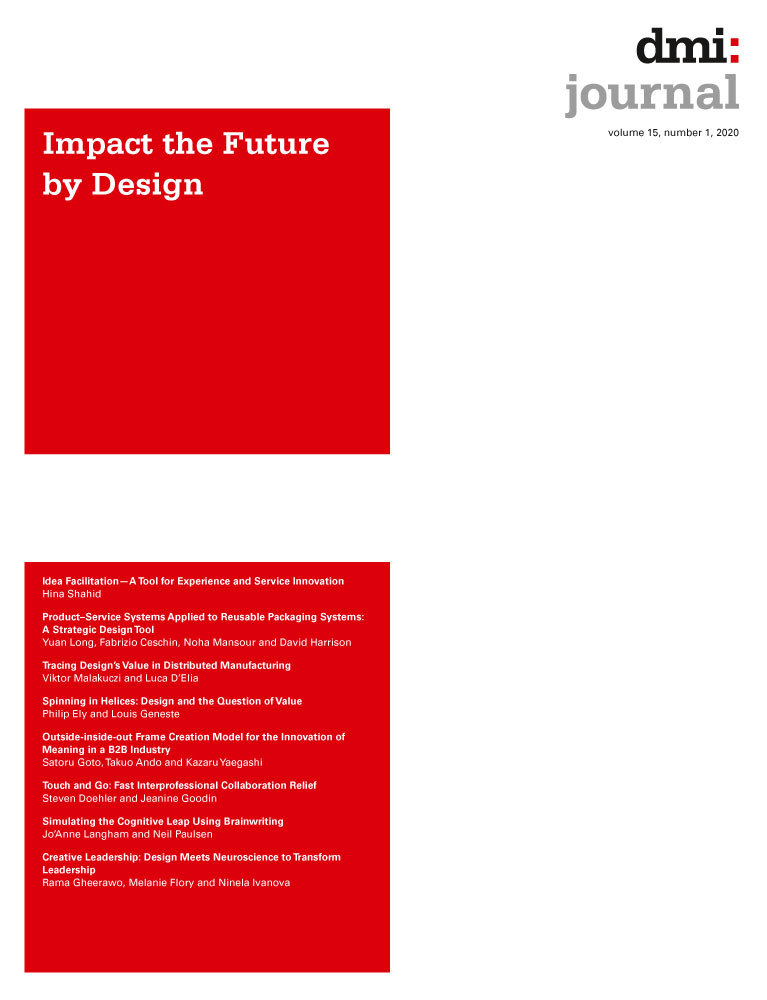Touch and Go: Fast Interprofessional Collaboration Relief
Abstract
Working collaboratively through interprofessional education is highly effective when solving problems in community health. Unlike in industry, academic collaborations are limited to class time and are often sporadic. This fragmentation often translates into teams not finding their stride until midsemester.
The Design + Nursing Collaboration (D + NC) developed the "Touch and Go" collaboration method to address this lag. This method focuses on bringing students together early to unite under easily completed tasks via in-person and distance collaboration. This method strategically brings designers and nurses together and then breaks them apart at appropriate moments to enable them to focus and excel in their area of specialty. The collaboration method allows students to come together and solve wicked problems as a large team. This method requires a diverse mindset, one that can see the broad view and address significant challenges from various perspectives. However, as the problems become more complex, disciplinary experts need to shine without compromise and break away and perform the tasks in their field of expertise.
The authors will outline and demonstrate the process, the outcomes, and how "Touch and Go" moved the solution further faster.
1 Introduction
At the University of Cincinnati, iterative interprofessional collaboration is the center of a decade of product and service development in the Design + Nursing Collaborative (D + NC). This interprofessional collaboration fulfills the academic requirements of two major disciplines, design and nursing, and positions students to learn skills and leverage knowledge to address community health challenges. To date, the D + NC has conducted approximately 15 studios, with topics including overbed tables, assistive mobility, head protection, concussion prevention, diabetes, thermal pain therapy, and a variety of occupational health and safety products.
Throughout the D + NC’s evolution, a collaborative method morphed and enabled student designers, nurses, and faculty to work together when appropriate and split when appropriate, creating a time- and phase-efficient collaboration method. Teams are encouraged to work together at all times, work out differences, and ultimately trust each other’s expertise. When managed well, these activities are effective and move without delay. But there are drawbacks, especially in an academic atmosphere. This environment is not a full-time collaboration. Students typically meet once or twice a week for a relatively short amount of time. It is challenging to create positive team dynamics while pushing for a well-thought-out solution. When operating under a typical collaborative model, the authors observed placing students in out-of-expertise, problem-solving situations was not effective. Placing students in unfamiliar learning situations is a positive aspect of collaboration, but, more times than not, it slowed the process. Although sharing ideas was beneficial, the problem-solving activities began at a base level where cross-disciplinary solutions collided and hit stalemates. Many times, students did not understand the concepts’ foundational inception, causing friction and skepticism. The faculty found that splitting teams at critical points of initial ideation, then bringing them back together to evaluate and validate concepts from a clinical and design perspective, moved the ideas further faster.
The teams’ participants were able to understand each other by executing tangible deliverables together. This understanding laid a unified foundation and made everyone’s role clear by highlighting the value of their complementary discipline. They could see solutions, ask questions (e.g., why), and then bolster the ideas by injecting their area of expertise. This interprofessional education method has been coined “Touch and Go.” In this paper, the authors outline each process step and explain why it works, the organization structure, and what results. The final section will describe project examples and highlight specific process aspects and a glimpse into the future of the D + NC as we move to mix more disciplines into our recipe.
1.1 What is interprofessional education (IPE)?
Interprofessional education provides students from different backgrounds with an opportunity to collaborate on group assignments to enhance future partnerships. In dissecting the term, Klein (2018, p. 11) states. “The prefix ‘inter’ typically connotes the integration of existing method, tools, concepts, and theories from two or more disciplines, and the linking and blending of these elements in order to advance fundamental understanding, or to address a complex problem or question.” Implementing IPE includes enhancing knowledge on the benefits of collaboration, increasing the knowledge of the roles of other disciplines, and encouraging students to consider different points of view when developing a solution to a problem. According to Khan, Shehnaz, and Gomathi (2016, p. e283), “a successful curricular innovation requires support from all stakeholders, as well as reinforcing collective ownership of IPE activities.”
Although challenges exist for institutions to implement IPE, such as scheduling of courses, the authors are supported by their respective colleges to provide this unique learning opportunity to students.
1.2 What is touch and go collaboration?
Touch and Go collaboration is a series of intense collaborative interactions combined with strategic intervals of discipline-specific breakouts. The authors have proven that forcing strict collaboration rules in areas of research, validation, and final presentations enables the student participants to understand the value each discipline brings to the project quickly, and students gain an understanding of how their skills complement their counterpart. This understanding is especially effective in early topic understanding activities. Student teams build through research and topic understanding and efficiently execute in less collaborative intense phases.
In phases where students are allowed to split and focus, they immerse themselves in their area of specialty. They know the parameters for success from their pure collaborative stages, and the curriculum structure keeps everyone congruent.
During this split, teams communicate weekly. They share ideas and give feedback. The intention is not to stop the collaboration; rather, it is to enable discipline-specific focus with less intense collaborative interactions, equaling quality results in a condensed time frame.
1.3 The touch and go setup
The collaboration has experimented with several groups of design students, ranging from third-year students to master’s-level students. Currently, the professors recruit from fourth-year industrial design. In nursing, Accelerated Master of Science in Nursing (MSN) prelicensure students are optimal. Our MSN students are individuals who have typically had work experiences in other fields and have decided to extend their careers to focus on nursing. This broad-based knowledge made them optimal collaborators.
It is essential to mention that each group of students voluntarily chooses to enroll in this course. This aspect ensures we do not have students participating whose hearts are not in it. Our past experiences show that when students are picked or not given an option to participate, negative disruptions occur in team dynamics and quality of work, and are an overall drag on the collaborative community.
Projects are typically selected by current community health needs and topic appropriateness for the student cohort. The projects gravitate toward topics that require a physical product, service, or experience component. This requirement satisfies the design students' need for acceptable portfolio projects. The nursing students are more topic flexible. They can apply strategies of community health to various conditions that involve groups of people.
Once a topic area is determined, fundamental principles of community health are applied: Primary, secondary, and tertiary care interests determine how teams are divided. This division allows the collaborative to dive deep into one specific topic, for instance, youth American football and concussions. In this actual case, the faculty divided the class into two teams for each category of primary, secondary, and tertiary. Students took a sharply focused direction on this topic. In other cases, the collaborative offered several topics and allowed students to select a focus, research that direction, and then determine a primary, secondary, or tertiary project direction. Both resulted in positive outcomes.
During the initial meeting for the nursing and design students, a course overview is provided, along with a review of the design and nursing process for both groups of students. Although this may sound like a fundamental idea for students who are over halfway through the required coursework for their respective degrees, the lead faculty found that this was essential in facilitating an understanding of how the processes are very similar for both disciplines. During the process overview, it is emphasized where students will collaborate and where they will work independently. All students are provided with a class schedule, indicating the specific deliverables required for each group of students at each phase of the process. The faculty have found that providing students with the expected deliverables at the beginning of the term significantly strengthened group dynamics and eliminated frustrations within teams that historically occurred during the concept refinement stage of the process.
2 Process phases
2.1 Understanding: inquiry
2.1.1 Design + nursing intense collaboration
Understanding is categorized as an “intense” collaboration phase. During this phase, design and nursing students work closely together. They conduct secondary research and limited primary research. At this point, the students understand why their problem is essential, its pathophysiological attributes, who is most affected, current condition interventions, and where the opportunity gaps are. Most importantly, they develop a list of requirements that they must adhere to, as designers and nurses, to produce a solution that will not only address the problem but also integrate into the users’ lives.
This phase is a three-week process. Students receive strict instructions on uncovering required deliverables, and the importance of delegating responsibilities is critical. Students must work outside of class to complete the phase, so group communication is also of high importance. Team dysfunctions typically emerge here, and faculty are ready to intervene. Providing intervention ensures everyone understands the process and roles. First and foremost, they know the success of the project lies in the team, not with the individual.
2.2 Conceptualization: preliminary intervention plan//population pyramid
2.2.1 Design conceptualization (Figure 1)
Design Conceptualization is a typical ideation phase with a significant caveat. Students reflect on understanding findings and specified design requirements. They use this information as the backbone of their conceptual iterations of product, service, and system solutions. During this time, the design students update their nursing collaborators at least once a week to ensure they are meeting clinical requirements. These meetings ensure concept generation is following clinical guidelines and achieving innovative solutions.
The conceptual exercises begin with thumbnail ideations and conclude with explanatory sketches vetted with the internal D + NC team.
The traditional view of creativity is that it is unstructured and doesn’t follow rules or patterns…. We believe just the opposite. We’ll show you that more innovation—and better and quicker innovation—happens when you work inside your familiar world.
This system includes five thinking tools.
- Subtraction
- Remove an essential component from a product and find a new configuration.
- Multiplication
- Find a key product component and add more of it.
- Division
- Divide a product into several specialized uses.
- Task Unification
- Enable one product task to perform more than one function.
- Attribute Dependency
- Attributes of the product can change, such as power output, color, and size.
This method was introduced as an in-class exercise, where student teams practiced the techniques on their projects. Next, the design and nursing teams convened to evaluate the current concept directions using the SIT process. By having the design students provide internally vetted concepts, as seen in figure 1, the collaborative teams were able to iterate and find new opportunities based on initial ideas. This process was especially useful for nursing students. In many traditional collaboration scenarios, students not educated in concept development do not participate. There is not a mechanism to allow those students to contribute in an equal manner. Using SIT allows nondesigners to contribute conceptually to the process on an equal playing field and contribute through intellect, not design execution skills.
Of the five thinking tools, Subtraction has proven to be the most effective for the D + NC. The process is as follows:
- The team selects the top three concepts.
- They list the functional components of each concept.
- From this list, they rank the top functional components.
- From these components, they subtract one of the top-ranked components.
- Now, they look conceptually at how their product, service, or system could work if that top-ranked component was subtracted.
This exercise made the team think in new directions. It involved everyone, and sometimes the result changed the project direction in unexpected directions.
After concluding this exercise, the teams were instructed to develop one last round of refined concepts, narrowing the total to three to five. These concepts were internally vetted, were visually understandable, and served as the primary research tool in subsequent phases. This split but integrated phase allowed focused concept production, fostered concept direction consensus, created unity in the team, and inspired team confidence that the concepts put forth were the best for gaining feedback.
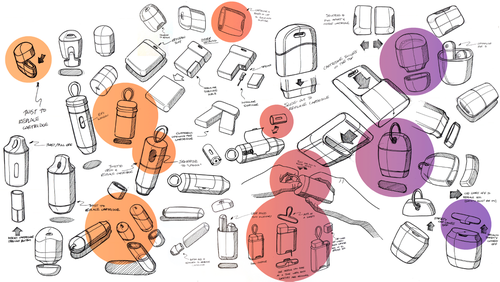
2.2.2 Nursing preliminary intervention plan
A population pyramid is a graphic presentation of the human population's age and sex composition for a specific region. One benefit of using a population pyramid is that it can be utilized for revealing historical and future trends (Korenjak-Cerne, Kejzar, and Batageli 2008, 157).
The nursing students also serve as a resource to the design students, providing in-depth content on pathophysiology and feedback regarding the end user’s use of the product. Preliminary interventions, including education modules, are developed.
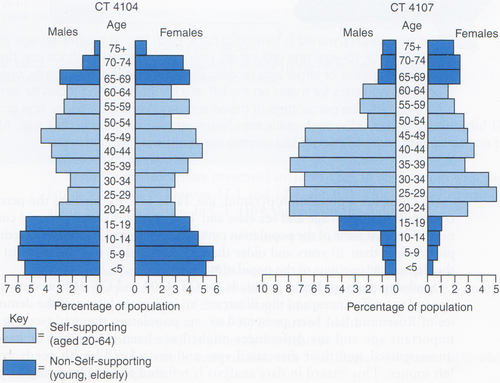
2.3 Concept validation: intervention validation
2.3.1 Design + nursing intense collaboration
The course only permits two weeks for Validation. This time frame includes participant recruitment, interview guide development, and summaries. Teams need organization, and tasks require delegation for proper fulfillment. This phase is an “intense collaboration” to determine whether their concepts and interventions are staying true to the requirements established in Understanding. Validation begins with a “soft” start in the last week of Conceptualization. This overlap allows teams to recruit and schedule face-to-face participant interviews early and begin interviewing at the beginning of Validation. Students quickly understand that these meetings must occur at the participants’ convincement, not theirs. Hence, during the last week of Conceptualization, students are contacting participants and scheduling interview times for the following two weeks. To gain insights teams use conceptual directions as tools for discussion, see Figure 3.
In the first week of Validation, there are lectures on proper interviewing techniques, survey targeting strategies, and question development for interview guides and surveys.
The importance of face-to-face interviews is stressed. Although it is well known that these types of meetings yield the best findings, they are also the most challenging for novice researchers. The faculty present students with documents highlighting best practices from both a question context and interview etiquette. They are taught to be aware of body language and, if lucky enough to interview at the participant’s home or work, how to observe the behavior or living environment. In addition to these benefits of conducting face-to-face interviews, Jamison et al. (2018) note that the interviewer also has the flexibility to modify the direction of conversation during the interview. Using online surveys is necessary as well. The faculty assists teams in finding online blogs and organizations to publish surveys and make sure their questions are directed toward the specific group. Online surveys also provide access to difficult-to-reach groups. Jamison et al. (2018) indicates in a recent study that both face-to-face interviews and online surveys are reliable methods to answer research questions; however, the online forum is better able to communicate participants’ viewpoints from a wide geographical area. Each project is solely a collaboration between students, and the information gained from these interviews with the end users is essential in providing students with direction for their projects.
At the end of two weeks, students present their findings (Figure 3). They review significant insights, potential concept refinements, and a determination of their one final direction.
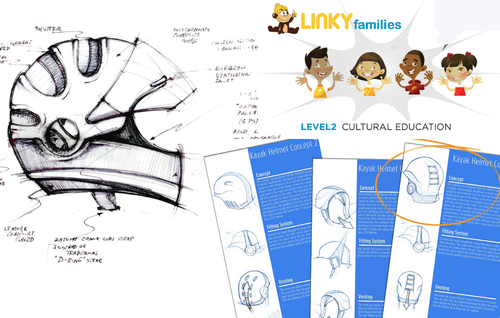
2.4 Concept refinement: intervention plan refinement
2.4.1 Design
In this phase, design students start the process of honing the selected concept by developing final Computer Aided Designs (CAD), explanatory imagery, animations, model making, and so forth, that bring together the vision of this well-vetted solution. As in Conceptualization, nursing students were kept aware of developments as the refinements proceeded. This is where trust in the process is critical. Students may need guidance to ensure they are staying true to the voice of the user, but from an executional perspective, they were expected to complete this independently (Figure 4).
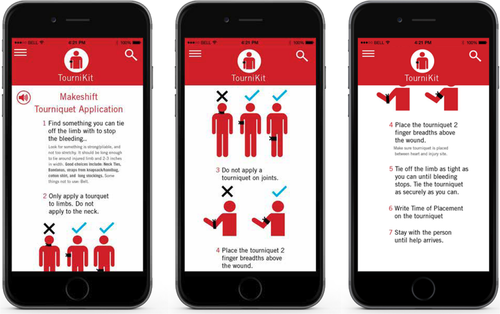
2.4.2 Nursing
In this phase, the nursing students carefully review the final selected concept and collaborate to develop necessary support interventions. These interventions generally include patient education materials, instructions for staff training on the final concept, and any other education essential to support the safe use of this concept. For some of our concepts, the design and nursing students have collaborated on the development of a simulation or a video demonstrating correct use of the concept, as well as training modules for end users .
2.5 Concept finalization: intervention finalization
2.5.1 Design + nursing intense collaboration
To finalize, the project teams prepare for the end-of-semester presentation. Designers and nurses review their semester’s work and develop a story that encompasses breakthroughs, drawbacks, and final results. Avoiding the typical critique, the D + NC embraces a participatory review. This review brings together experts from area commercialization centers and shares innovation with the community. Representatives from those entities participate in the final evaluation. The goal is to move our ideas past the portfolio or résumé and into partnerships that could directly benefit from the solution.
The end-of-semester format has taken several shapes, but the most successful was a speed-dating format (Figure 5). Students teams developed a comprehensive 10-minute presentation to share with invited reviewers, who are experts in the fields of design, nursing, and entrepreneurialism. The faculty selected a representative from design and nursing to give an overview of the project and semester goals. Faculty divided critics into review teams and the students presented, allowing productive presentation time and maximizing exposure. Every 15 minutes, guests were asked to rotate. At the conclusion, reviewers approached the project teams and asked more detailed questions. During this time, reviewers voted on their favorite projects. The winning team received a gift, and there was a big celebration. But what is more important than the winner and the ceremony was the fact that an expert evaluated each team. These experts could fund an aspect of the student project or the entire project.

3 Process results
The following projects exemplify the D + NC process. Although several D + NC projects did possess excellent attributes, the selections give readers an optimal overview of successful studio experiences. These examples outline successful team dynamics, complementary skills, and very well-thought-out results backed with clinical knowledge.
3.1 Project 1: youth American football
Industrial design student: Lauren Sebastian
Nursing students: Kevin Gibboney and Corey Salyer
3.1.1 Topic significance
In 2012–2013, several academic medical faculty within the University of Cincinnati’s College of Medicine (COM) developed a Sports Neuroscience Initiative with the goal of bringing innovative, collaborative university research teams together to work toward one goal—to improve the health of student–athletes and enhance their safe participation in high-level athletic programs without risk of lifelong repercussions. The D + NC participated in this initiative by developing conceptual innovation for several sporting activities susceptible to concussion. One area of focus was American youth football (AF). Youth football was selected because American tackle football reports the highest injury rate for all contact sports (Gilbert and Johnson, 2011).
This sport exposes young people to violent collisions with equipment designed for much older players. Also, concussions received when the brain is still developing can have catastrophic effects on long-term development, causing several disorders, including learning disabilities, and increase the individual’s susceptibility to future concussions. One phenomenon that has been revealed through postmortem research on the brains of football players is that of chronic traumatic encephalopathy (CTE), which is a degenerative brain disease resulting from repeated trauma to the head (Gilbert and Johnson, 2011). Tsushima et al. (2016) noted that athletes in high-contact sports, such as football, experienced more subconcussive impacts, thereby negatively affecting speed and reaction time. Also, youth participation in high-contact sports could lead to persisting neurocognitive and developmental deficiencies, often resulting in impaired behavioral functioning and reduced academic performance (Gilbert and Johnson, 2011; Tsushima et al., 2016). This collaborative team chose to address primary preventative solutions to youth football by not only addressing head protection but also designing a system that fits and prevents upper body movements that cause a concussion.
In researching this topic, students found equipment worn by adults was retrofitted for children, making the concussion protective effectiveness much less than optimal. Also, at the age when young people are introduced to AF, their growth is anything but uniform. Some players are fully grown by 13, and others have yet to hit their full size (Figure 6).
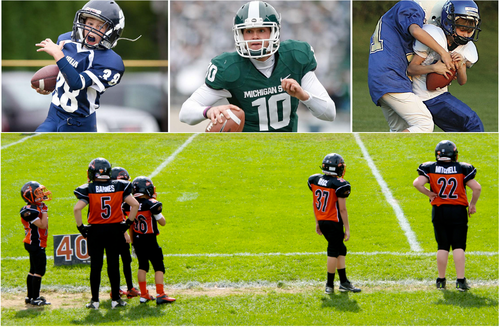
3.1.2 Area of team excellence
In the initial research phase, the team gained a deep understanding of the pathophysiological aspects of youth concussions. This understanding enabled the designers to get early conceptual visions of how to address these facts. The team also completed significant work in identifying varying body characteristics. This proved to be a substantial factor when addressing equipment adjustability while maintaining safety requirements.
3.1.3 Collaborative innovation results
After gaining a complete understanding of the issues surrounding concussions in youth football, the team began to look past the helmet. The nursing students found that concussions occur not only from a blunt force contact but also a whiplash motion. With this knowledge, designers conceptualized an upper torso and head garment. This garment connected the large muscles and bone structures of the torso to the head and neck, taking the structural responsibility off the underdeveloped neck muscles and dispersing it to other body areas (Figures 7,8 and 9).

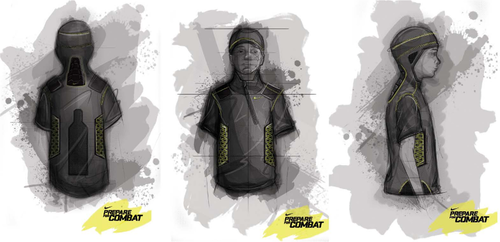
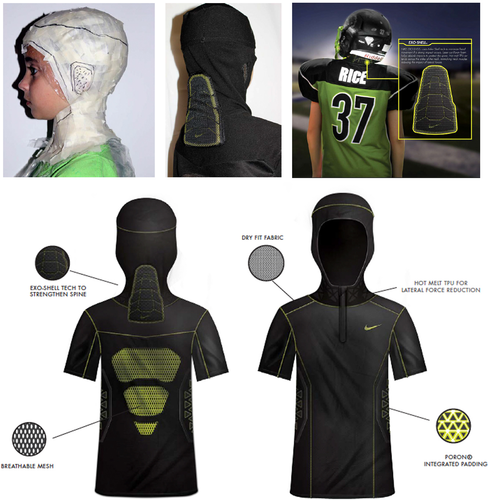
3.2 Project 2: auto-injector (Figure 10)
Industrial design student: Mary Friedl
Nursing student: Sarah Glasgo
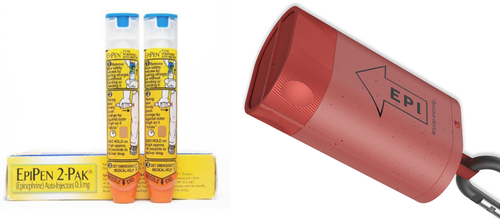
3.2.1 Topic significance
In researching the topic of allergies and EpiPens, this team found statistics indicating the number of those suffering from allergies was on the rise, and the supply of this vital medication was in high demand but difficult to obtain. The research found traditional EpiPens often expired before use, and there was no affordance to reuse. The team also found this delivery system was not easy to obtain.(Figure 11)

3.2.2 Area of team excellence
In the Validation phase, this team discovered a dual-dose refillable system was highly desirable. They presented several concepts that include aesthetic, functional, and clinical features and benefits. They found that EpiPen users are supposed to carry two pens but typically do not, it is not illegal for users to replace cartridges (but it is for pharmacists), and many try to hide their pens because they are unattractive and do not make them feel empowered. This collaborative activity allowed the team to gather product and process insights and was effective in providing them with a final direction. (Figure 12)
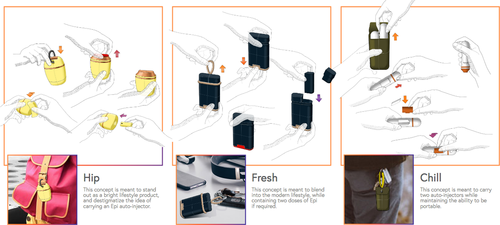
3.2.3 Collaborative innovation results
The final result was a dual-use refillable system whose instructional method guided users through the process using both audio and written instruction. The internal component configuration ensured sterilization through a single use, double use, and refilling. The aesthetic was sophisticated, honest, and nonthreatening. This system allowed the primary injection system to remain for several applications, with only the medication cartridge needing replacement. An easy-to-follow instruction pamphlet accompanied the packaging. This, combined with the audio instructions, made using this system very intuitive. Making the main housing robust and designed to last several iterations of use and replacement made only the medicine cartridge disposable and significantly reduced the amount of plastic use over long periods. This product was sustainable on several levels. (Figure 13)

3.3 Project 3: UV nebulizer
Industrial design student: Gabriel West
Nursing student: Sarah Glasgo
3.3.1 Topic significance
Although functional, it is more challenging to receive a proper medication dose with an inhaler versus a nebulizer. Nebulizers are aerosol drug delivery devices that help administer medication to the lungs. (Figure 14) Nebulizers typically treat respiratory illnesses and break down medical solutions into a mist that the user can inhale. While nebulizers are a useful tool to help treat people with respiratory issues such as asthma, many fail to maintain their machines properly, resulting in less effective treatments. Specifically, most users fail to sanitize nebulizer components properly. The team’s goal was to redesign the nebulizer in a way that naturally addressed this issue and enhanced homecare experience by using UV light technology.
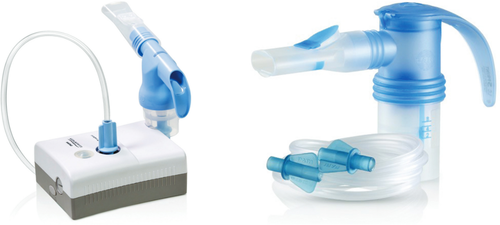
3.3.2 Area of team excellence
This team was very efficient in determining the actual aspects of nebulizer sanitation and discovering what technology could assist. They found users rarely sanitized their machines. And if they did, it was not to manufacturers’ recommendations. The research also discovered that nebulizer pieces were not always dishwasher safe. (Figure 15)
They found the most common nebulizer issue was a failure to adhere to proper sanitation techniques. Inadequate cleaning and maintenance were imperative to optimize machine performance. Failure to adhere to recommended standards would not only hinder medication delivery but also heighten the risk of infection. Improperly maintained parts also housed dangerous pathogens such as Pseudomonas spp. As a result, many users could experience a worsening of their respiratory symptoms using their nebulizer rather than obtain the expected signs of relief.
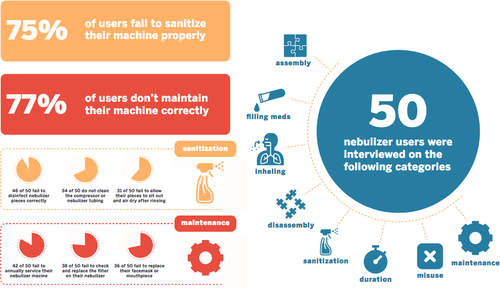
3.3.3 Collaborative innovation results
With these sanitary considerations as a backdrop, the team developed a nebulizer system that integrated the medication aerosolization with a storage/sanitizing system. The storage/sanitizing system engulfed each component with ultraviolet light, thus sanitizing it while not in use. By combining the delivery, storage, and sanitizing systems into one device, they developed a safe, convenient, and useful product. (Figure 16)

4 What’s on the horizon
The Touch and Go collaboration method has enabled designers and nurses to collaborate in a very effective way. Students experience collaboration in a way that allows them to immerse and then disseminate. This cycle allows them to dive deep with each other when it is most critical and separate when discipline-specific activities warrant attention. Using this process, the studio’s output has been impressive. Students have received awards, employment, entrepreneurial funding, and top-level portfolio projects to share with perspective employers. From a research perspective, this process has enabled the authors to determine the key attributes of collaboration and develop a unique experience that moves project progress at a faster rate by reducing the collaborative learning curve and providing calculated phases where students can focus on discipline-specific tasks.
Looking at the collaborative future, the authors intend to expand this opportunity to other students in the university. To do this, they are starting the process of migrating the collaborative into the university’s honors program. Historically, the D + NC has been a noteworthy experience for those whose passion focuses around community, health, and wellness. To expand the collaborations knowledge, the honors program will provide an extremely diverse discipline pool. By adding a more diverse knowledge base, the project outcomes are forecasted to become even more dynamic.
As we move forward, we intend to expose more students and faculty to the Touch and Go collaborative process and use this process to help communities become healthier.
Biographies

Steven Doehler Steven is an expert in the areas of experience design, user centered product development, and interface design. He received a BFA from the University of Illinois Chicago and MA from the Ohio State University. Professionally he has worked in consulting and corporate environments and started several private ventures. As a University of Cincinnati faculty member in the Industrial Design Program, he specializes in healthcare and design entrepreneurialism. At UC he is an active collaborator with faculty and students from Nursing, Business and interacts with several private entities. His numerous publications/presentations are internationally recognized and his students have won several design awards as well as placement in many of the worlds top design organizations. Hi latest venture 39A LLC bridges the gap between UC’s School of Design talent and the regions small business and startup ecosystem.

Jeanine Goodin Doctorally prepared, registered nurse experienced in both academic and adult clinical environments. Have over 28 years of clinical practice in the community, acute care and critical care settings, and have 18 years’ experience in academics. Coordinated large classes with multiple faculty teaching in the course. Maintain active clinical practice as a Family Nurse Practitioner. Enthusiastic and goal-directed to enhance the clinical proficiency and cost-effective delivery of high quality care to patients across the life span. Excellent leadership, organizational, inter-professional collaboration, and interpersonal skills. Actively involved in professional organizations at the local level. Maintains clinical proficiency and professional certification in neuroscience nursing and as a family nurse practitioner.



